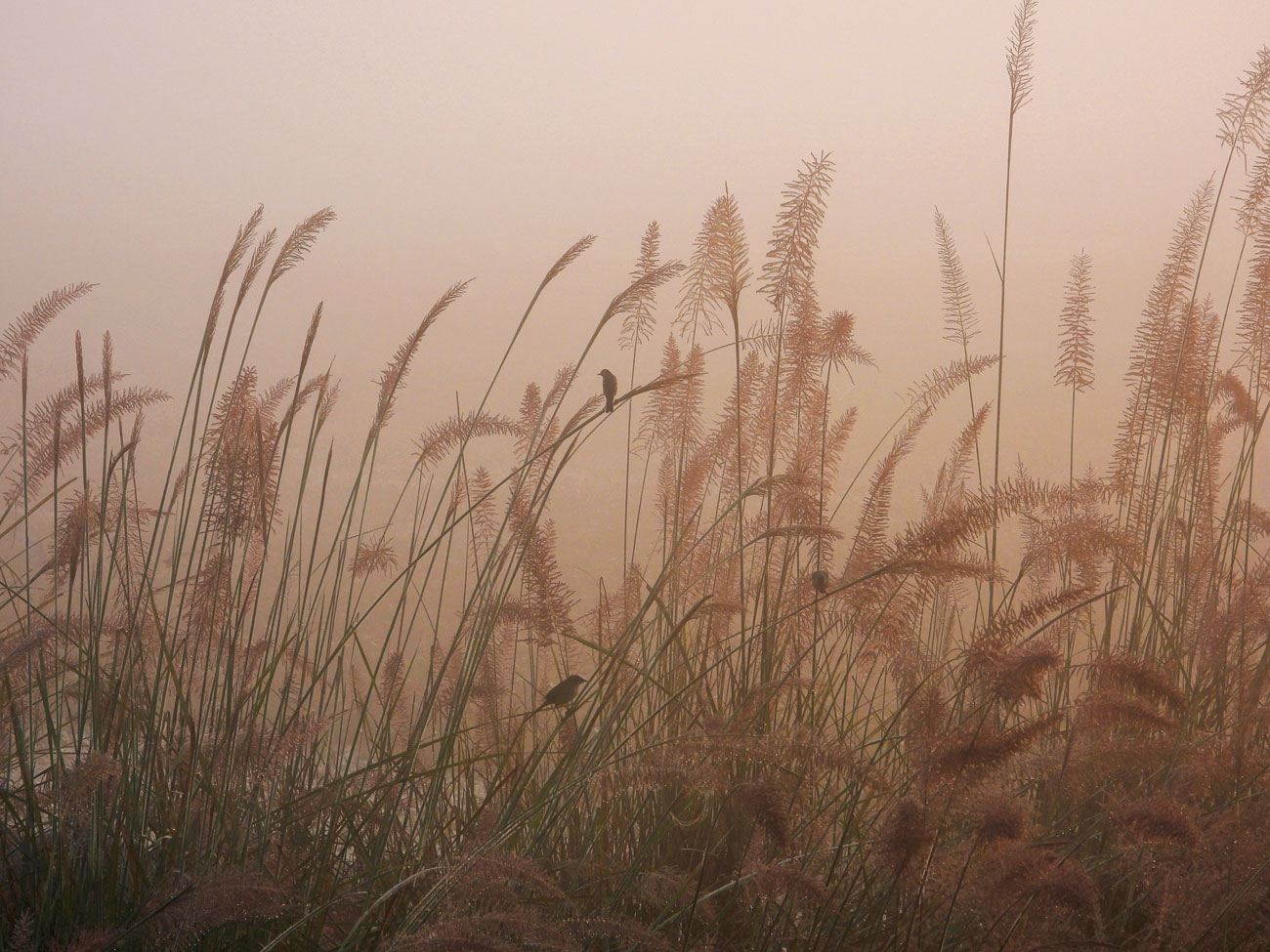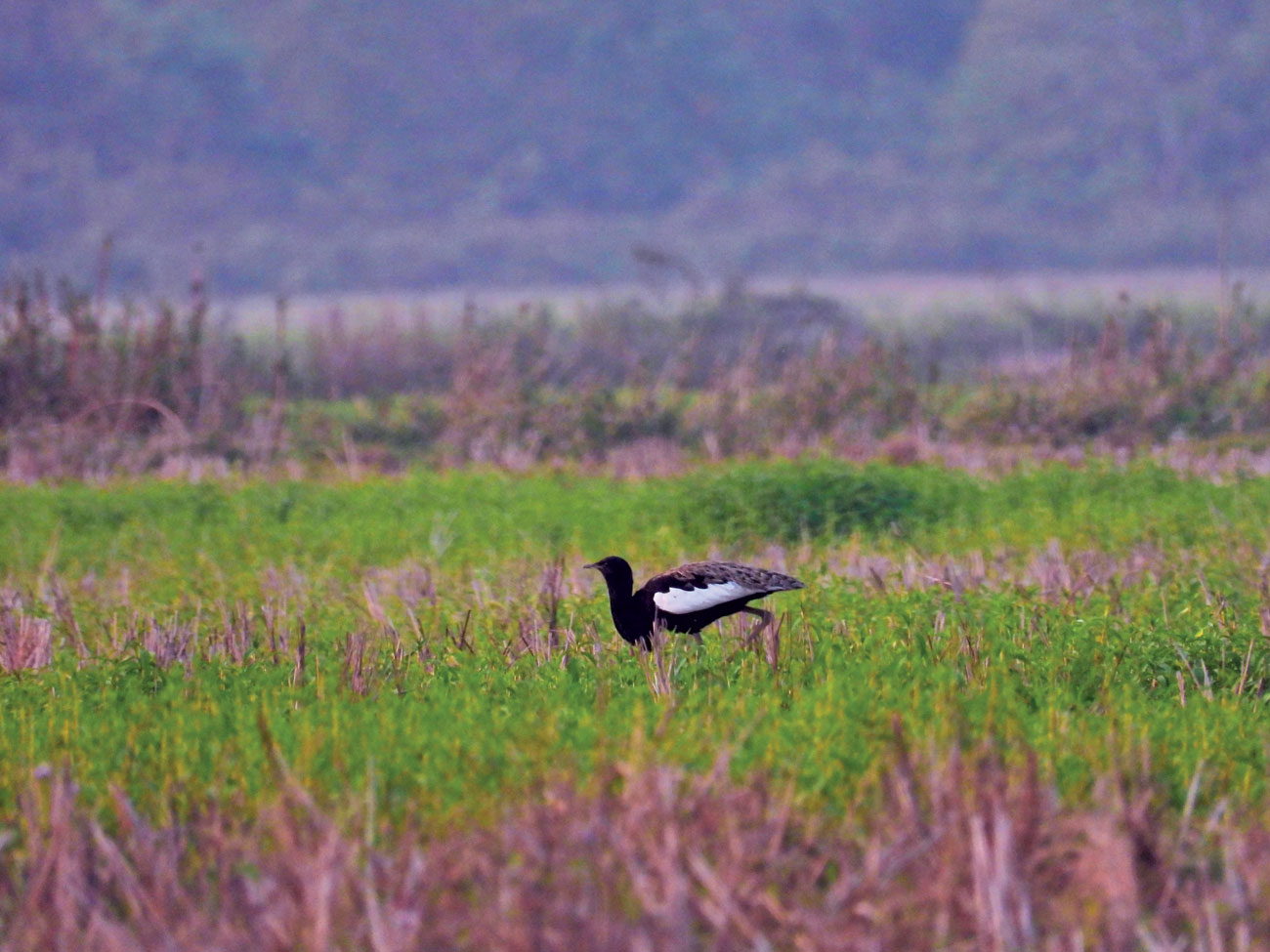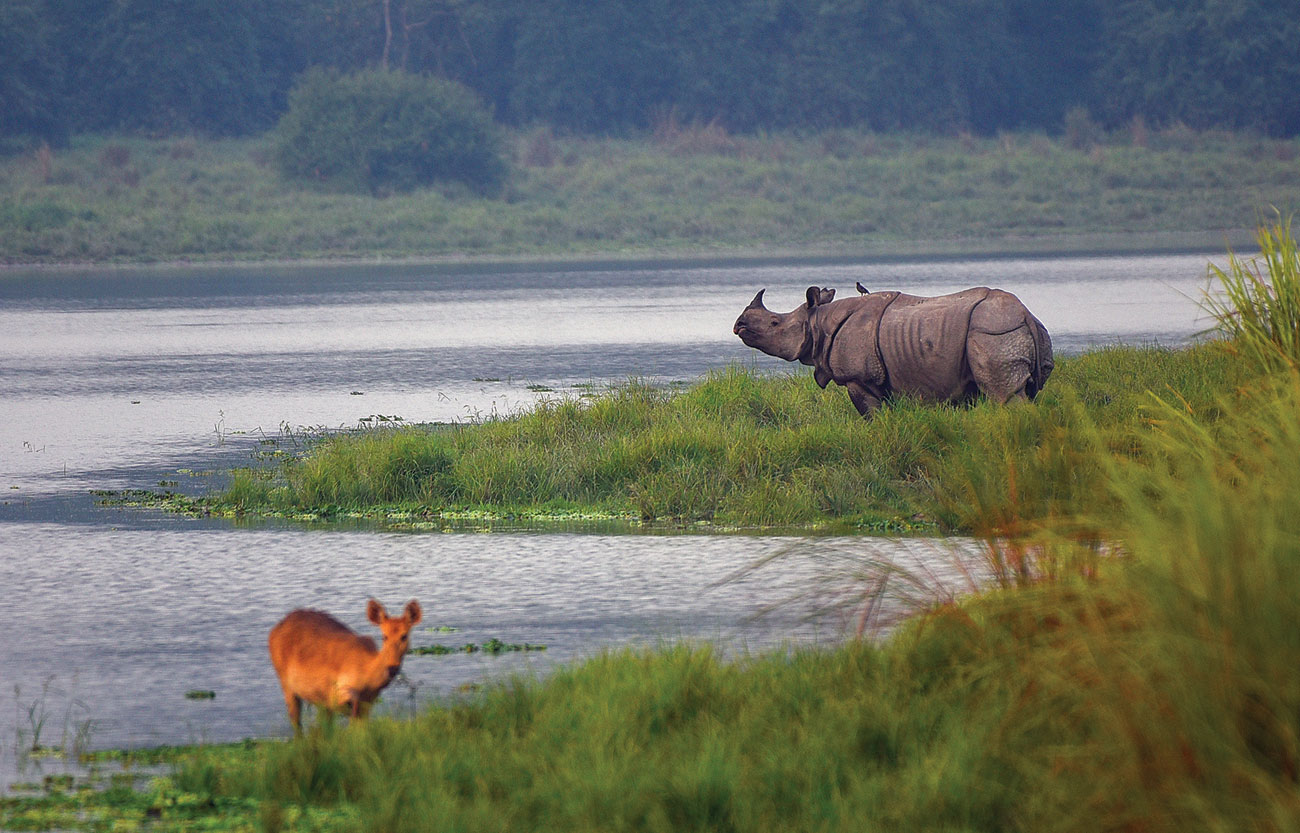Beyond The Tigers Of Terai
First published in Sanctuary Asia,
Vol. 45
No. 4,
April 2025
By Kaushik Sarkar
When we hear the names Dudhwa, Pilibhit, Chitwan, Manas, or Kaziranga, what animals come to mind? For many, it's the majestic tigers, the mighty rhinos, and the gentle giants – elephants. These iconic creatures are some of the most charismatic species of the Indian subcontinent. But have you ever paused to consider what else ties these Protected Areas that span across India and Nepal, nestled at the foothills of the Himalaya?
The answer is two-fold: First, they are all tiger reserves. Second, each one is home to the unique and invaluable terai grasslands. Now, you might wonder, what exactly are terai grasslands? And what sets them apart from other ecosystems?

Tall grasses are very important for grassland specialists and winter migrants alike. Here a Striated Grassbird, a Bluethroat and a Citrine Wagtail are foraging in a patch of flowering Narenga porphyrocoma. Photo: Kaushik Sarkar.
In the July-August 1991 issue of Sanctuary Asia, Dr. Asad Rahmani and Qamar Qureshi delved into this question in their piece, The Threatened Terai. They painted a vivid picture of these grasslands and their crucial role in the survival of many species, offering insight into an often overlooked but vital part of the landscape:
The terai is a flat, alluvial, often marshy, strip of land about 1,600 km. long and 50 to 60 km. wide. It lies between the Himalayan foothills and the Gangetic plain and in the Assam Valley. The soil of the terai is clayey, boulderless and has a high moisture content. The water table is high, and the rainfall varies from 1,000 mm. in the west, to over 2,000 mm. in the east. In some places, extensive patches of elephant grass, interspersed with tracts of dense forest, dominated by sal Shorea robusta, still exist. In bygone days, the terai was largely inhabited by tribals called Tharus. A virulent form of malaria prevented colonisation of vast tracts of the land. The British loathed the area, despite the fact that the sal here was first grade and the grasslands provided the finest tiger hunting. Thus the Tharus (who had developed a rough immunity to malaria) and the wildlife, were left in relative peace. However, the discovery of DDT, which controlled malarial mosquitos, suddenly opened the terai to colonisation in the early 1950s. Within a decade, extensive tracts of virgin forests and grasslands were put to cultivation. Villages and small towns sprang up and sugarcane fields replaced natural grasslands. Soon, the Tharus, the original owners of the land, became landless labourers, victims of the wily farmers who usurped the land. Needless to add, most of the wildlife was devastated.
Understanding The Terai
As described above, the terai is a mosaic of grasslands, wetlands, and rivers interspersed between the sal Shorea robusta forests, with each season bringing a different colour in the grassland, driven by the growth and flowering of the grasses. Over the past three years, my work in the Dudhwa Tiger Reserve has taught me more about the terai than what I could learn by reading alone.
Unlike the dry savannah grassland of the Deccan plateau formed on account of low rainfall and volcanic soils properties, terai grasslands are moist, tall grasslands formed on the alluvium deposited by the meandering Himalayan rivers and maintained by cycles of flooding, fire and herbivory. The region terai, which means ‘inundated’, spans across the foothills of the Himalaya, extending from Uttarakhand, eastwards to Uttar Pradesh, Bihar, Bengal, Assam and Arunachal Pradesh.
When I saw the satellite images of the landscape, my understanding of these river-formed grasslands became more intuitive. I saw that all grasslands within the Dudhwa landscape are arranged in a linear fashion and are either adjacent or parallel to a river or a channel, indicating that flooding in those adjacent rivers and course change led to the formation of these grasslands.

Illustration of the various species of grassess found in the Terai landscape. Illustration: Urvi Shah.
By virtue of the alluvium, the terai grassland soils are nutritionally rich and support fast growth of grasses with high productivity. I have seen a completely burnt grassland become lush green within a span of 15-20 days. Historically, these grasslands were thought to have supported the largest amount of herbivore biomass on the planet; this in turn supported a large number of predators. Likewise, they still remain hotspots for tigers, elephants and rhinos.\
But the terai is more unique and diverse than its megafauna. Living in terai grasslands requires specialisations, which include adaptation to floods, fires, food choices and the overall habitat features, and the same is exhibited by many endemic species of that landscape.
The grasses of the terai are also dependent on the annual flooding, herbivory and fire cycles to thrive. These species have evolved to survive in inundated conditions with a dense rhizome network. They also depend on fires to get rid of the dry leaves so fresh shoots can grow. But the most astonishing thing I noticed in the terai was that the grasses are tall, very tall, some more than six metres in height! I saw elephants and rhinos disappear in these tall grasses like a needle in a haystack.
Tall grasses in the terai are often sharp, loaded with silica, making them tough to eat. Only megaherbivores such as water buffalo, Indian rhinos, and Asian elephants can munch through their tough leaves and stems. Each grass species is finely tuned to specific soil moisture levels, creating patches of tall and short grasses across the landscape.
The changing seasons bring vibrant hues to the grasslands. In autumn, the flowering Saccharum spontaneum turns the fields white. Early winter brings the red and gold hues of Narenga porphyrocoma and Themeda arundinacea. By late winter, the grasslands dry out, taking on an amber-brown shade. In spring and summer, fresh green shoots emerge after the annual fires. Smaller grasses such as Imperata cylindrica, Desmostachya bipinnata, and Cymbopogon martinii bloom in white or gold during the summer.

Terai grassland obligates such as the Bengal Florican and pygmy hogs, with less than 250 wild individuals globally, are standing at the edge of extinction owing to the immense challenges faced by these grasslands today, which range from poor management, invasive species and smaller habitat patches to disease outbreaks. Photo: Kaushik Sarkar.
At first, the flowers were my only way of identifying the grasses. They also revealed which species dominated specific areas, influencing which birds thrived there. These dynamic grasslands gave rise to grassland-specialist birds such as the Bengal Florican, Swamp Francolin, Indian Grassbird, Jerdon’s Babbler, and Chestnut-capped Babbler. Migrant species, too, find these grasslands perfect for wintering, and during my work monitoring avifauna, I spotted winter migrants such as the Yellow-breasted Bunting, West Himalayan Bush Warbler, White-throated Bushchat, Chinese Rubythroat, and Pied Harriers.
Ungulates such as the swamp deer and hog deer have adapted to thrive in the swampy, wet grasslands. The swamp deer, in particular, leads an amphibious lifestyle, relying heavily on aquatic vegetation for sustenance. Among the herbivores, the hispid hare is unique to these terai grasslands, depending on the tall grasses such as Themeda arundinacea and Narenga porphyrocoma for survival. Without these grasses, the hare's existence would be in jeopardy.
A Magnificent But Poorly Understood Landscape
It’s hard to imagine how much more wildlife once thrived in these grasslands, as what remains today is but a shadow of its former grandeur. The tragic reality is that many of the species mentioned – such as the Bengal Florican and hispid hare – are now classified as threatened by the International Union for Conservation of Nature (IUCN). This decline is the result of massive habitat loss over the last century, driven by colonial exploitation, excessive hunting, agricultural expansion, conflict, and the relocation of human settlements.
Today, the few remaining functional grasslands exist only within a small number of Protected Areas scattered across the terai, such as Dudhwa, Pilibhit, Chitwan, and others. These areas are mere fragments compared to the vast, thriving ecosystems that once spanned the landscape.
Terai grassland obligates such as the Bengal Florican and pygmy hogs, with less than 250 wild individuals globally, are standing at the edge of extinction owing to the immense challenges faced by these grasslands today, which range from poor management, invasive species and smaller habitat patches to disease outbreaks.

The Indian rhino and barasingha cross paths in the verdant Kaziranga landscape. Terai grasslands are moist, tall grasslands formed on the alluvium deposited by the meandering Himalayan rivers and maintained by cycles of flooding, fire and herbivory. Photo: Dr. Anish Andheria.
In fact, even two seasons of intense surveys couldn’t help us find a single individual of the Bengal Florican in the Dudhwa landscape between 2022 and 2024, and fears rise that they may be locally extinct as they haven’t been sighted since 2019 in the Protected Area.
Despite the challenges, organisations such as The Habitats Trust are working to conserve these species and habitats in collaboration with respective Forest Departments and concerned NGOs. The attempt has been to bring these species back from extinction and, in the process, maintain and conserve the functionality of these delicate terai grassland ecosystems. The concerted efforts have led to partial restoration of some patches in Manas and Orang Tiger Reserves in partnership with Aaranyak, as well as better management of some grasslands, which then support the grassland obligates that keep the grasslands functional.
What this demonstrates is that grasses and grassland-dependent species are as critical as tigers in these landscapes and we need to save these fragile habitats with much more fervour. With ongoing efforts, there is hope that these grassland specialists will thrive once again, helping to preserve the delicate balance of these ecosystems and ensuring that the tigers, rhinos, and elephants can continue to captivate our imaginations in these beautiful terai ecosystems.
Kaushik Sarkar is a wildlife biologist learning his ways in conservation practice. He is currently a Senior Executive at The Habitats Trust.





